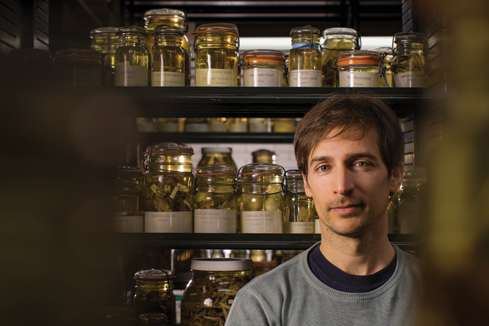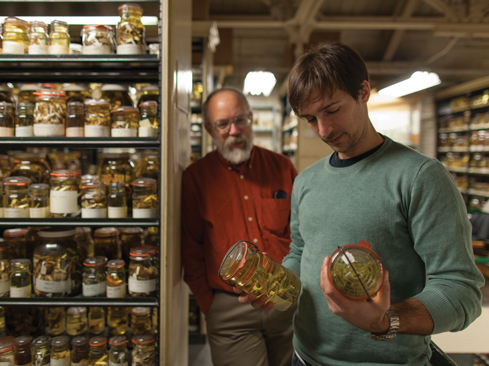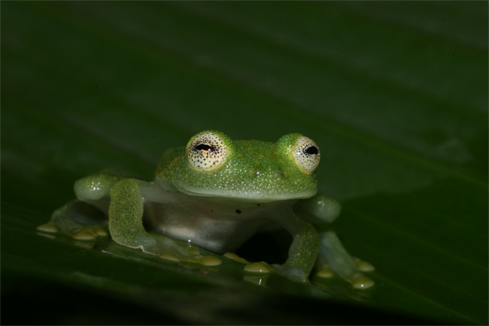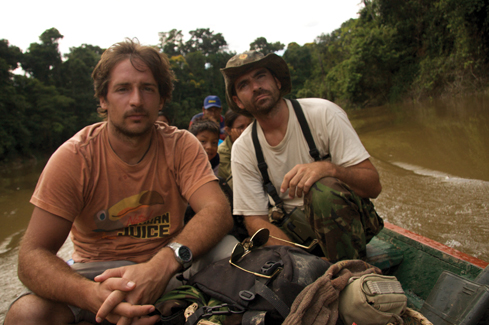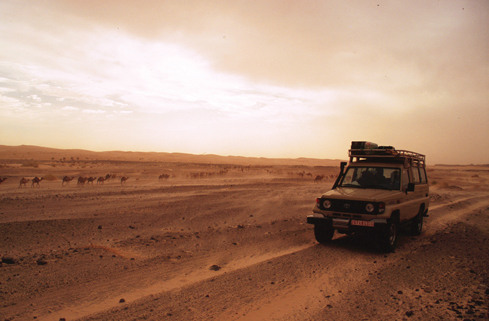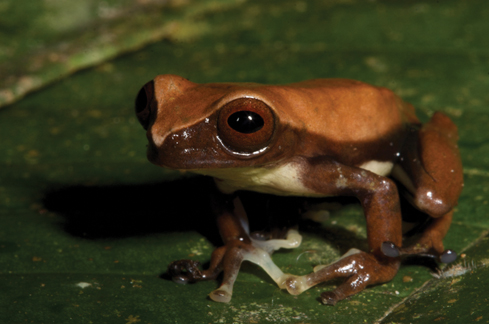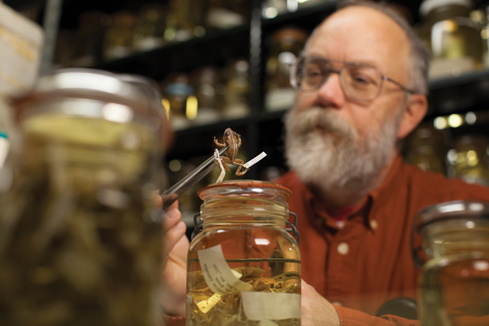 |
||||||||||||||||||
|
Creatures of the Wild
José Padial, the Museum of Natural History’s new head of herpetology, might be just as much a creature of the wild and mysterious areas he explores as the species he studies there.
In 1996, José Padial boarded a small, single-engine Cessna for his first journey into the tropical wonderland that is the Amazon. When the plane finally landed in a small clearing in the middle of the Bolivian rainforest, he got out and got to work. He was only 19 years old. “It was incredible!” he recounts, smiling broadly, of his eight months volunteering for a conservation group. “They sent me there to do an inventory of the birds and mammals, and I was working with two Guarani Indians. My routine was to wake up early to check my nets for birds. After I took down that data, I walked the rest of the day to see what I could find, including amphibians and reptiles along a nearby lake. Then I would come back at sunset and we would take a canoe around the peninsula and fish for our dinner.” Months passed, and in addition to a plethora of wildlife, the young Spaniard—then an undergraduate in zoology—discovered there was already an abundance of researchers and research materials focused on birds and mammals. Not so with the crazy variety of slithery creatures occupying just about every few feet of ground space in the Amazon. “I saw frogs, snakes, lizards everywhere,” he says, “and it was almost impossible to know what they were; there was no literature. So I got very interested. I really wanted to know what those things were, and what was the composition of those species in that community, in that ecosystem.” “It’s the practical reason we do what we do; we want to know what organisms are living on this planet with us.”
–Jose Padial, William and Ingrid Rea Assistant Curator of Amphibians and Reptiles
The following year, the die for Padial’s future was cast when he accepted an invitation to speak about his research on birds. It was then he met an Argentinian researcher working on amphibians (frogs and salamanders) and reptiles (snakes, lizards, turtles, and crocodiles) in the Gran Chaco, one of the largest dry forests in the world, encompassing parts of Argentina, Bolivia, and Paraguay. “It was fantastic!” Padial recalls with excitement. “It was exactly the kind of thing that I wanted to do. He was studying a huge ecosystem that is almost the size of a quarter of the United States, and there was almost no information on amphibians and reptiles there. “I decided that, for me, what was most important was to contribute to a field where there was not much known,” he continues, “because what makes for a happier researcher is to discover.” Sixteen years later, Padial is Carnegie Museum of Natural History’s new William and Ingrid Rea Assistant Curator of Amphibians and Reptiles (also known as herpetology), an endowed position established by The Heinz Endowments in honor of the Reas, two passionate supporters of the museum. At age 36, he’s assuming responsibility for a revered collection of more than 207,500 specimens and a research section with a history of international, national, and much regional discovery, albeit not for a long while. The section has been without a full-time curator and without new collection activity for at least 10 years.
Padial is ready to fix that. He has the scientific chops: He’s already discovered about 50 new species of reptiles and amphibians, most of them frogs. And, on average, he collects a few hundred specimens a month on his field expeditions to the Amazon and the Sahara. At least half of his future finds will now be coming to Pittsburgh (the other half must, by law, remain in the country where the specimens were found). “I was so happy when I saw that José was barely in the building and was gone again, with funding for another expedition to Peru,” says John Rawlins, referring to Padial’s January trip to Alto Purus National Park, a preserve in one of the Amazon’s most diverse and unexplored forests, which is home to some of the world’s last indigenous people who have no contact with the outside world. Rawlins, the museum’s longtime curator of invertebrate zoology and currently one of its interim directors, served on the search committee to fill the curatorial spot. “I wanted someone who would come in and really build the collection,” he says, “someone who had the skills and the daredevil-ness and the international experience to do that.” Padial more than fit the bill. Knowing what’s out therePadial, born and raised in Granada, Spain, doesn’t consider himself a daredevil. First and foremost, he says, “I’m a naturalist. I could work with almost anything that is or was alive. And I like the study of the history of organisms and the history of the earth. “Just the process of discovering and learning is so exciting to me,” he adds, almost wistfully. “It’s like when you love art and you go see an exhibit, and you get so excited by the idea that humans produced those things. Well, that’s how I feel about nature. I go there and I’m just completely amazed.”
Ever since his kismet moment in 1997, Padial has focused his passion for discovery on the study of reptiles in Northern Africa and the mountains of South America, as well as frogs—his favorite research subject—in the lowlands of the Amazon. He seems to relish the entire process—from the field work, to the jigsaw-puzzle-like analysis and research collaborations that follow, to the publication of his findings. “He’s one of those gonzo field scientists. And he’s already accomplishing so much.”
–Darrel Frost, Curator of Herpetology at The American Museum of Natural History“He’s put a lot of attention on the formal logic of how we figure out evolutionary relationships,” says Darrel Frost, curator of herpetology at the American Museum of Natural History in New York, where Padial was a postdoctoral fellow. “Just because two things look similar, you assume they’re related. But in a rough and tumble way, lizards are a lot more related to us than they are to salamanders.” Padial notes, however, that before you can study evolution, protect wildlife, or find new medicinal properties in nature, all natural-history research starts with the same thing: discovering what’s out there.
“It’s the practical reason we do what we do; we want to know what organisms are living on this planet with us, where they are, how many of them there are,” he says. “We talk about the Amazon, the Sahara Desert, the West Indies, and how wonderful they are; but we don’t know what’s living there. We have only just begun to scratch the surface.”
But what’s the point, really, of researching frogs in Brazil? Why the need to collect lizards in the Sahara? “You need people doing things that seem so disconnected from our daily lives,” Padial explains. “It’s important to have the scientific infrastructure producing knowledge. We need to build the machinery now to make scientific progress in the future.” Nature’s laboratoryIn the late ‘80s, Michael Zasloff, a researcher at one of the world’s leading incubators of scientific knowledgeturned- application, the National Institutes of Health, stumbled upon one of the numerous qualities that so attract scientists to the study of frogs. In Padial’s words, “They have perfect skin.” After surgically removing the ovaries of African horned frogs for a research project, Zasloff was amazed to see that when he returned the frogs to their aquariums, they quickly began healing without the benefit of antibiotics. That led Zasloff to the discovery that the skin tissue of African horned frogs possesses unique antimicrobial compounds. He and other scientists have gone on to learn that other species of frogs produce their own unique kinds of antibiotics. Padial notes that today, many medicines, particularly antifungals and antibiotics, owe their existence to frogs. “Frogs mostly live in wet environments that are full of bacteria, and their skin is very sensitive because they breathe through their skin.” Nature is the ultimate laboratory, Padial professes, and its organisms leave plenty of breadcrumb trails to amazing discoveries. You just have to be patient enough, and determined enough, to follow them. “What I find today might end up being the most important thing 20 years from now,” he says. In his own field of study, he explains, “When you discover a frog that has certain substances and you know the relatives of that frog, by investigating those relatives you can find the same substance modified in certain ways. Once you study whole families of substances, because evolution has been working on those organisms for many millions of years, you may find that some of the variants are going to be more effective.” It’s that great potential for practical application, coupled with the sheer love of nature and exploring it, that leads Padial back to the Amazon, time and again. “It’s like an evolutionary machine,” he gushes. “It’s an area that has produced, for some unknown reasons, incredible amounts of diversity.” In one locality no bigger than the size of Carnegie Museums’ Oakland campus, he notes, “you have more frogs than you have in the United States and Canada together.” Padial remembers vividly the first time he discovered a new frog species. It was 2006, on an expedition in the rainforest of the Madidi National Park in Bolivia. “I remember that feeling. Usually toads are terrestrial, but I found a toad that climbs in the trees and has very long legs. It was a very, very special animal. I was excited.” He named it after the Tacana tribe native to the area: Rhinella tacana. He’s since named about 30 other new species, with 20 or so still to be named. Padial notes that his research serves another, very practical purpose: wildlife monitoring and conservation. “We provide a lot of information for the government agencies in those countries,” he explains. “In protected areas, we produce basic information about what they have in those areas and what they need to protect. And we work with CITES, a treaty that regulates the trade of wildlife. There could be no control of what crosses the border without basic research by people like me.” Wild thingsIn what he calls his most exciting project to date, Padial and three colleagues have assembled a consortium of 25 researchers from 15 countries in the first broadscale analysis of species diversity in the Amazon. First up for study? Frogs. “We convinced these researchers to donate tissue samples of species of frogs from their collections so that we can sequence information from their genes to evaluate the genetic diversity of amphibians in the Amazon—because genetic diversity often mirrors species diversity,” he explains. “I think the results are going to be very important.” Meanwhile, Padial, joined by colleagues around the globe—and, now, at Carnegie Museums—will continue exploring. “I’ve already talked with him about collaborating on a few wild adventures,” Rawlins asserts, with a grin. “This guy is wild,” he adds, referring to Padial’s fearlessness in the field, something Rawlins knows plenty about. “He’s one of those gonzo field scientists,” adds Frost. “And he’s already accomplishing so much.”That includes work in perhaps the most trying of natural conditions, the Sahara Desert. For all of Padial’s love for the Amazon and its natural treasures, his face lights up in a particular way when talking about his field work in the Sahara. “It’s a special place,” he says, his voice softening. “It’s tough, but at the same time it has so many surprises. And the people living there are so well adapted, living with almost nothing but still managing to have a good life. “There isn’t the same diversity in the Sahara,” he notes, “but the adaptations are quite impressive.” His favorite? The sand fish, a reptile that traverses the sand dunes much lik e dolphins glide through the ocean. “When you see it, you think, ‘How did that happen? How could something so special like that evolve?’ It’s wonderful.” And wild. No doubt, something Padial appreciates. Scientific Sharing
Last year, Steve Rogers, the Museum of Natural History’s longtime collection manager for amphibians and reptiles (as well as birds), got a call from an Alabama postdoctoral researcher with no small request: “She wanted a few hundred wood frogs to see if there were differences in their extremities over time,” Rogers recounts. No problem, he told her, and he proceeded to do what he’s done countless times for countless individuals and organizations: He visited the museum’s strange and wonderful “alcohol house”—with its three floors and many metal shelves lined with thousands of jars of amphibians and reptiles preserved in alcohol—where he would have to spend many hours removing specimens from jars and preparing them for shipping. It’s not a money-making venture. Rather, notes Rogers, it’s a service museums provide to each other in the name of scientific advancement. Today, the museum’s amphibian collection boasts about 65,000 salamanders and 54,000 frogs, and the reptiles portion has around 29,500 snakes, 29,500 turtles, and 30,500 lizards, as well as a few other orders of specimens. The collection is well rounded in all groups with good-sized collections from many parts of the United States and about 170 other countries or island nations. Thankfully, in the late 1970s, Carnegie Museum of Natural History began entering the detailed information on its amphibian and reptile collection into a database. While, today, the alcohol room looks pretty much the way it has for decades, Rogers can now electronically search the collection—ranked about tenth in the world for its diversity and number of specimens, now 207,500—a huge timesaver. He’s proud of the database, and how the museum has joined with other peer institutions in linking their collection databases to the web-searchable networks of “HerpNET” and “VertNET.” And he’s especially happy to welcome José Padial, the department’s new assistant curator, who will be bringing hundreds of new specimens home with him after most of his expeditions— even though it will mean more work for Rogers. “It’s time we build the collection again,” he says.
|
||||||||||||||||||
Under the Influence · The Shape of Things · The Carving Out of a Collection · Director's Note · NewsWorthy · Face Time: Nina Marie Barbuto · Artistic License: Permantly Interesting · Science & Nature: Survivor's Tale · About Town · The Big Picture
 |
Copyright © 2017 CARNEGIE Magazine. All rights reserved. |

